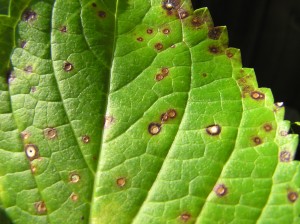As the hot weather abates just a bit, gardeners find themselves back in the landscape only to find an outbreak of spots on their plants. Hot, humid and rainy weather are perfect conditions for the development of fungal diseases.
One of the most common leaf spot diseases seen in the landscape during late summer is Cercospora leaf spot. While it affects many different landscape plants, it is most commonly seen on hydrangeas. It affects smooth, panicle, oakleaf and bigleaf types of hydrangea. However, this year, there have been numerous occurrences on crape myrtles.
Symptoms
On bigleaf hydrangea, the spots are small, circular and have a purplish halo surrounding them. The centers of these spots eventually turns tan to light gray in color. In contrast, the leaf spots on oakleaf hydrangea appear angular in shape and are dark brown in color. Leaves that are severely affected often become a yellow-green color.
Initial symptoms on crape myrtles are the appearance of dark brown spots that develop first on the lower leaves and progress upward in the canopy from mid-summer through fall. Infected leaves develop a yellowish to orangey-red coloration because of the production of a toxin by the pathogen. These leaves then fall prematurely, particularly in highly susceptible varieties.
Numerous infectious spores are produced in the center of each fungal spot. These spores can be spread by wind, splashing water and can hitch a ride on pruning tools. Frequent late summer rain showers will not only greatly increase the rate of disease spread, but also intensify the level of leaf spotting and defoliation. Extended periods of drought will usually suppress disease development and spread.
Although this disease can be visually alarming, it is generally an aesthetic problem for homeowners because the disease rarely kills the plant. However, if this disease is severe, it can reduce the overall plant vigor by repeated defoliation.
Control strategies
There are some fungicides available to help manage Cercospora leaf spot, but for the homeowner, disease management with fungicides is often not warranted because symptoms usually occur so late in the season. This does not mean, however, that you should ignore the problem. Once this disease is found in a planting, yearly outbreaks are likely to occur.
The fungus easily survives on fallen leaves. Sanitation is perhaps the most important tool in disease management. Be sure to remove and destroy these leaves to help prevent future infections and disease outbreaks.
Another important cultural practice includes surface watering. Because moisture on the leaves allow disease spores to germinate, avoid getting the leaves wet with overhead irrigation. Also be sure to apply enough nitrogen to maintain a moderate growth rate. It is also helpful if your plants are not crowded. Good air circulation permits the leaves to dry quickly after a rain, which helps prevent leaf spot diseases.
However, the use of fungicides may be justified for high-value landscape plantings that develop severe cases of the disease each year. Products containing chlorothalonil, myclobutanil or thiophanate-methyl are recommended. For effective control of Cercospora leaf spot with a fungicide, begin applications when spotting of the leaves is first seen and continue applying that treatment as needed. Be sure to follow label directions!
- Crane Flies - April 18, 2024
- Rosemary - March 7, 2024
- The Franklin Tree - January 18, 2024

